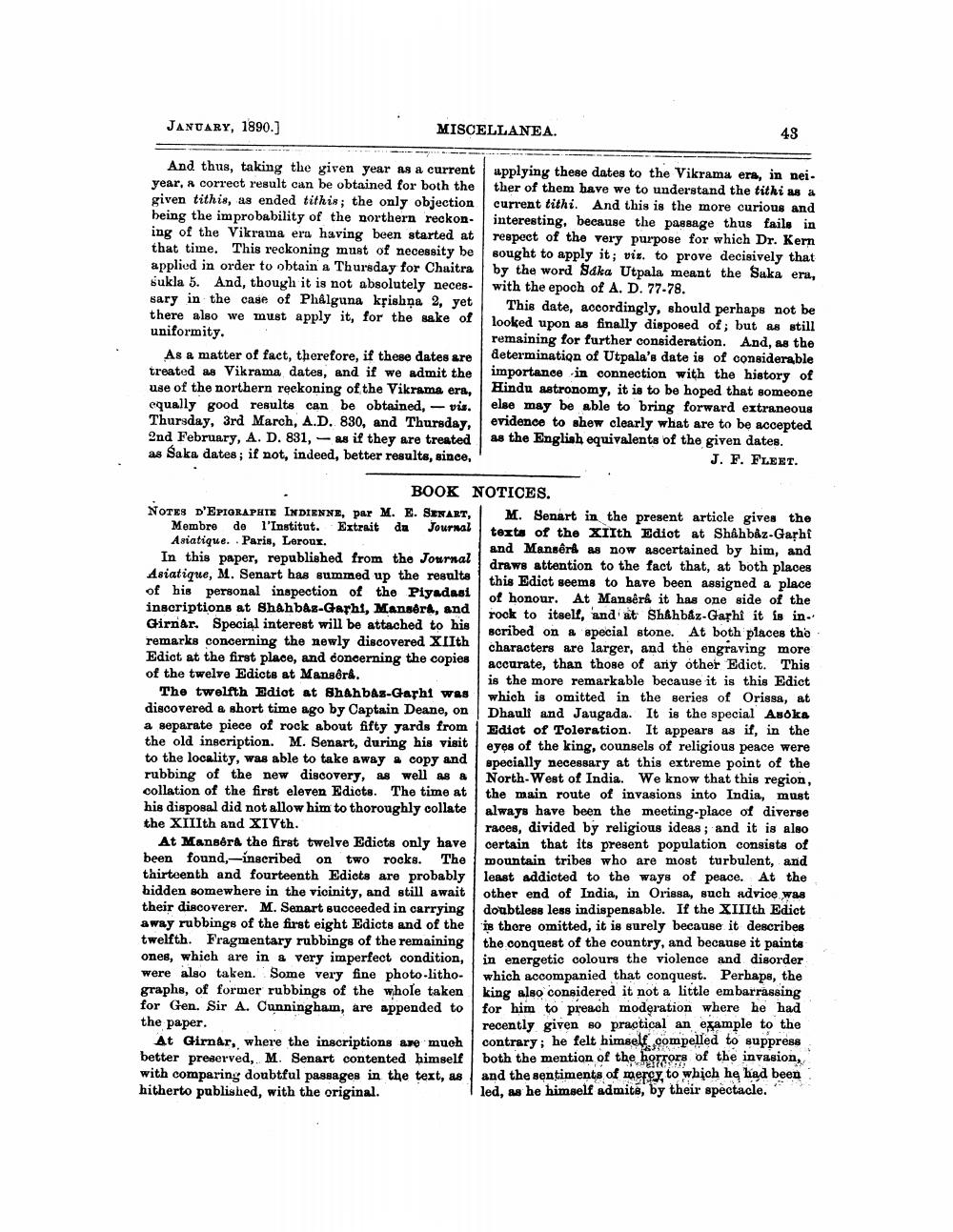________________
JANUARY, 1890.]
And thus, taking the given year as a current year, a correct result can be obtained for both the given tithis, as ended tithis; the only objection being the improbability of the northern reckoning of the Vikrama era having been started at that time. This reckoning must of necessity be applied in order to obtain a Thursday for Chaitra sukla 5. And, though it is not absolutely necessary in the case of Phalguna krishna 2, yet there also we must apply it, for the sake of uniformity.
MISCELLANEA.
As a matter of fact, therefore, if these dates are treated as Vikrama dates, and if we admit the use of the northern reckoning of the Vikrama era, equally good results can be obtained, - vis. Thursday, 3rd March, A.D. 830, and Thursday, 2nd February, A. D. 831, -as if they are treated as Saka dates; if not, indeed, better results, since,
-
BOOK NOTES D'EPIGRAPHIE INDIENNE, par M. E. SENART, Membre de l'Institut. Extrait da Journal Asiatique. Paris, Leroux.
In this paper, republished from the Journal Asiatique, M. Senart has summed up the results of his personal inspection of the Piyadasi inscriptions at Shahbaz-Garhi, Mansera, and Girnar. Special interest will be attached to his remarks concerning the newly discovered XIIth Edict at the first place, and concerning the copies of the twelve Edicts at Mansora.
The twelfth Edict at Shahbaz-Garhi was discovered a short time ago by Captain Deane, on a separate piece of rock about fifty yards from the old inscription. M. Senart, during his visit to the locality, was able to take away a copy and rubbing of the new discovery, as well as a collation of the first eleven Edicts. The time at his disposal did not allow him to thoroughly collate the XIIIth and XIVth.
At Mansora the first twelve Edicts only have been found,-inscribed on two rocks. The thirteenth and fourteenth Edicts are probably hidden somewhere in the vicinity, and still await their discoverer. M. Senart succeeded in carrying away rubbings of the first eight Edicts and of the twelfth. Fragmentary rubbings of the remaining ones, which are in a very imperfect condition, were also taken. Some very fine photo-lithographs, of former rubbings of the whole taken for Gen. Sir A. Cunningham, are appended to the paper.
At Girnar, where the inscriptions are much better preserved, M. Senart contented himself with comparing doubtful passages in the text, as hitherto published, with the original.
43
applying these dates to the Vikrama era, in neither of them have we to understand the tithi as a current tithi. And this is the more curious and interesting, because the passage thus fails in respect of the very purpose for which Dr. Kern sought to apply it; viz. to prove decisively that by the word Saka Utpala meant the Saka era, with the epoch of A. D. 77-78.
This date, accordingly, should perhaps not be looked upon as finally disposed of; but as still remaining for further consideration. And, as the determination of Utpala's date is of considerable importance in connection with the history of Hindu astronomy, it is to be hoped that someone else may be able to bring forward extraneous evidence to shew clearly what are to be accepted as the English equivalents of the given dates. J. F. FLEET.
NOTICES.
M. Senart in the present article gives the texts of the XIIth Edict at Shahbaz-Garhi and Mansêrê as now ascertained by him, and draws attention to the fact that, at both places this Edict seems to have been assigned a place of honour. At Mansêrâ it has one side of the rock to itself, and at Shahbaz-Garhi it is inscribed on a special stone. At both places the characters are larger, and the engraving more accurate, than those of any other Edict. This
is the more remarkable because it is this Edict which is omitted in the series of Orissa, at Dhaul and Jaugada. It is the special Asoka Edict of Toleration. It appears as if, in the eyes of the king, counsels of religious peace were specially necessary at this extreme point of the North-West of India. We know that this region, the main route of invasions into India, must always have been the meeting-place of diverse races, divided by religious ideas; and it is also certain that its present population consists of mountain tribes who are most turbulent, and least addicted to the ways of peace. At the other end of India, in Orissa, such advice was doubtless less indispensable. If the XIIIth Edict is there omitted, it is surely because it describes the conquest of the country, and because it paints in energetic colours the violence and disorder which accompanied that conquest. Perhaps, the king also considered it not a little embarrassing for him to preach moderation where he had recently given so practical an example to the contrary; he felt himself compelled to suppress both the mention of the horrors of the invasion, and the sentiments of mercy, to which he had been led, as he himself admits, by their spectacle.




